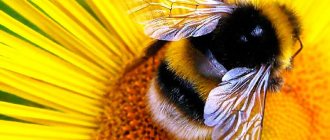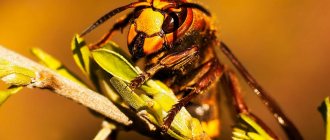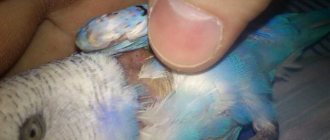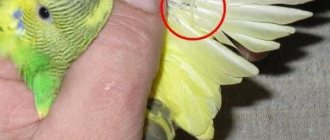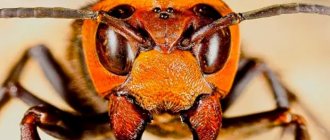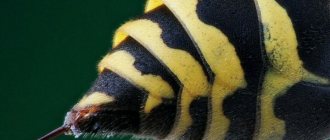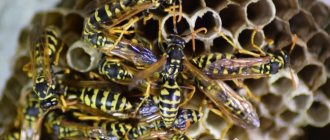A menacing buzzing makes many people anxious, and if something similar to a hornets’ nest appears in sight, there is a desire to get as far away from the dangerous place as possible. This is how people react to a potential threat. And this is correct, because the maximum risk of a bite occurs within a radius of 2–3 m from the nest.
Who is a hornet and why is it dangerous to humans? What to do if it bites and what could be the consequences? How to get rid of them and how do they differ from bees, wasps and bumblebees? Let's figure it out.
Who is the hornet
This is the largest representative of the so-called paper or social wasps. Their Latin name is Vespa, which literally translates as “wasp”. However, these are different insects that belong to the same family - true wasps.
Initially, no difference was made between the two representatives, and only in the 19th century the Vespa genus was divided into two groups. The description was based on several characteristics, but the main one was size - hornets are larger and can reach a length of up to 5.5 cm. Insects that are today considered wasps are designated in Latin as Vespula, that is, “small wasp.” Their size is 1.5–2 cm in length.
In the names of the hornet, given to it by residents of different countries, the roots of the words “horns” and “head” can be traced, which indicates the peculiarity of its structure - the increased size of the head and the presence of movable antennas. The fear of the hornet is reflected in the names - “evil man” (Old Russian, Polish), “pirate”, “winged corsair”.
The hornet's threatening appearance is given by the bright coloring of its head - a combination of yellow, black, and orange. The aggressive image is complemented by a striped belly, strong jaws and large eyes. However, these insects, unlike wasps, are non-aggressive. Human bites occur when a nest is disturbed or in self-defense.
Listen to the sound of the hornet:
Biological description
Hornets belong to the genus - social wasps. They live in families. A swarm can include up to several thousand individuals. Their life processes are clearly organized. Thus, within the “community” there are separate “castes” that perform specific functions.
The task of the hornet queen is to leave offspring. She is the leader of the colony. Females are born from fertilized eggs in August and September. Hornets reproduce by mating mature insects. After the females are fertilized, the males die.
The female stores sperm during the winter. With the onset of warm spring days, the queen begins to actively feed and regain strength in order to begin creating honeycombs for laying eggs. Thus, it forms the foundation of the future nest.
How long a hornet lives depends on its “profession”. Thus, males exist for one season, and the lifespan of the queen is a year.
In workers and the uterus, at the end of the abdomen there is a reproductive organ - the ovipositor, which is also a sting. In normal condition it is located inside. At the base of the ovipositor there is a paired gland containing a reservoir of poison that has a complex chemical composition. The hornet's sting is straight and smooth. The venom contains toxins that can affect the victim's nervous system.
The insect also has powerful jaws - mandibles. Literally speaking, hornets not only sting by injecting poison, but also bite. The insect uses mandibles to tear and grind prey.
During the active season, hornets feed on the juice of overripe fruits, trees, and honey. They hunt caterpillars, dragonflies, flies, spiders, related bees and wasps. They also cope with larger insects - crickets, locusts. There are descriptions of species capable of attacking birds and frogs. The prey is not used for food—the mass chewed and treated with saliva is used to feed the larvae.
Nests
The structure of a hornet's nest is based on hexagonal honeycombs.
The material is a substance similar to paper or cardboard. This is a lightweight structural element with thermal insulation properties of a brown color, which is obtained by mixing tree bark with insect saliva.
The place for the nest is chosen by the queen hornet. She does it where the offspring will be protected from excessive heat, cold and prying eyes.
Hornet nests reach 50–70 cm in length and are located in tree hollows, abandoned or used premises, cavities under roots, and piles of dead wood.
In the European Union, hornets are protected by law. For example, in Germany, the destruction of their nests is punishable by a large fine.
Area
Most species of hornets live in areas with a temperate climate, mainly in the northern hemisphere. Entomologists believe that they originally lived primarily in East Asia. There are several types of hornets on the territory of Eurasia, mainly the common and oriental ones.
People themselves play a major role in the spread of the insect. For example, a representative of the “common” species came to North America along with colonists from Europe in the middle of the 19th century.
In Russia, the hornet lives on a vast territory, which includes the European part of the Urals, Transbaikalia, the Amur region, and southern Sakhalin.
Kinds
Representatives of the extensive Vespa genus include more than 20 species.
- Affinis - small striped one.
- Analis - found in East Asia, measuring 25–28 mm.
- Basalis - basal.
- Bellicosa - warlike.
- Bicolor - two-color.
- Binghami - Binghama - active at night.
- Crabro - ordinary.
- Ducalis - commander's - one of the largest in Russia.
- Velutina is tropical, but also lives in Europe, as it was accidentally introduced there.
- Dybowskii - Dybovsky - almost monochromatic - black-brown.
- Fervida - ardent.
- Fumida - variable.
- Mandarinia is the largest in the world and also very poisonous.
- Mocsaryana - lives in Asia.
- Multimaculata - multi-spotted.
- Orientalis - eastern.
- Philippinensis - Philippine.
- Luctuosa is tropical, found in the Philippines and is the most poisonous.
- Simillima - similar, very similar to the common hornet.
- Vivax - lives in Asia.
- Soror - black-tailed.
- Tropica - tropical.
Eight species of hornets live in Russia. The leader in occurrence is the “ordinary” (Vespa Crabro), which is distributed throughout almost the entire country, including the Moscow region. It is absent only in northern latitudes. The eastern hornet (Vespa Orientalis) lives in the Caucasus. In the south of the Far East, six species of Vespa are found - Simillima, Dybowskii, Ducalis, Mandarinia, Analis, Dinghami.
Common hornet (Vespa Crabro)
Role in nature
Hornets occupy their niche in the environment. Like all participants in biological processes, they play a positive role in nature. But sometimes they can also cause harm. For example, they gnaw on trees, trying to get to the sap.
The benefits that hornets bring:
- destroy harmful insects that parasitize garden crops and wild plants - aphids, mites, psyllids;
- pollinate plants;
- They hunt locusts, flies, wasps, sick, “old” bees.
Natural enemies of hornets in nature limit their population within useful limits and destroy sick individuals. Among animals, these are ants, some species of birds (starlings, wagtails). Hornets are also susceptible to parasites - mites, nematodes, parasites and even microscopic fungi.
Interesting Facts
There are more than 20 species of hornets in the world, differing in color, behavioral characteristics, and size. The largest representative is the Asian one (Vespa Mandarinia), whose length exceeds 5 cm. In China, it is known as the “bee tiger”. Its venom contains a neurotoxin.
The hornet's queen releases pheromones that influence males. With their help, the “queen” organizes the activities of the entire swarm.
In the 18th century, the French naturalist, physicist and mathematician René Antoine Reaumur studied the material from which wasps build their nests. The result was a proposal to use wood in the production of paper, because until that moment, it was made from rags.
Why is a hornet dangerous for humans?
Insect venom contains a number of toxic substances that can act not only at the site of the bite, but also affect the entire body.
The following components of the poison pose a danger to humans:
- phospholipase A2 is an enzyme that activates the inflammatory response;
- acetylcholine is a neurotransmitter that ensures the transmission of impulses;
- histamine is a mediator of immediate allergic reactions;
- mastoparan is a toxin of protein origin.
As a result of the influence of a “bouquet” of biologically active substances on the tissues of the human body, a protective systemic inflammatory response develops.
A hornet sting can be fatal to humans if the victim experiences an allergic reaction. The following complications may also develop:
- skin rashes;
- bronchospasm - obstruction of the airways with difficulty exhaling;
- hallucinations;
- paroxysmal pain in various parts of the abdomen, nausea, vomiting;
- convulsive syndrome;
- depression of consciousness;
- a sharp decrease in blood pressure with further cessation of blood circulation.
Single hornet bites during pregnancy and lactation do not pose a danger to the fetus and infant, since the amount of poison is insignificant to penetrate the placental barrier or into the liver of a nursing mother.
How dangerous is a hornet bite for a child? Due to the small body weight, the concentration of poison for his body is very high, so the symptoms are more pronounced. And also due to the fact that children react actively and unpredictably to buzzing insects, the risk of multiple attacks increases, increasing the development of allergic reactions. In order not to risk the child’s life if bitten, you should immediately call an ambulance, without waiting for allergies to appear and anaphylactic shock to develop.
Stung by a hornet: what to do?
First aid when at least one of the symptoms appears is as follows.
- First, the affected area of skin is carefully examined. It is rare, but it happens that a hornet leaves a sting in the body. This happens when the insect is swatted during contact with the body. The sting is carefully removed with disinfected tweezers or a needle.
- The wound itself is treated with a cotton swab soaked in hydrogen peroxide and a weak solution of potassium permanganate. If you don't have these products on hand, you can simply rinse with cold, clean water.
- Ice, a cold compress, a plastic bottle of water, frozen meat in a bag, and a cold heating pad are applied to the puncture site to slow down the spread of toxins in the body.
- A saturated saline solution and crushed aspirin tablet are applied to the bite site to relieve itching. For the same purposes, fresh cucumber, parsley or dandelion juice, cabbage or plantain leaves are used.
- Suprastin, Diphenhydramine, Pipolfen or another antihistamine is taken orally.
- Provide plenty of fluids.
- To relieve swelling and swelling, the skin is lubricated with hydrocortisone ointment or cream containing lidocaine.
Attention! Damage to the mucous membrane of the mouth and throat requires an immediate call to the ambulance and in-hospital therapy, which boils down to the introduction into the body through a dropper of solutions that promote the rapid elimination of poisons. Untimely assistance after a hornet sting or poor quality treatment can lead to disastrous results.
Causes of a hornet sting
The main reason for a hornet bite is self-defense, and it always tries to get away from a person first and stings only if it is grabbed.
The insect uses its sting only for the purpose of protection or to neutralize a resisting victim. Entomologists explain that hornets will not consume poison without justified biological expediency. After all, this is a valuable weapon that is necessary during hunting.
Having detected a threat, hornets release alarm pheromones, which call on other individuals to attack. Therefore, everyone who is within a radius of 2–3 meters from a disturbed nest or a killed hornet will be bitten.
First aid after a bite
First aid after a bite
If a large black-striped wasp attacks a person, then it is necessary to provide him with first aid as soon as possible in case of a hornet bite:
- Move with the victim away from the site of the insect attack, sit down and loosen tight-fitting clothing (collar, belt, etc.).
- Visually inspect the affected area for any remaining sting and remove it from the skin using tweezers.
- Try to suck the poison out of the wound as quickly as possible.
- Rinse the area with cold water, treat and disinfect with alcohol, potassium permanganate solution or soap, wiping with a cotton swab to remove pathogenic bacteria.
- You can apply a damp lump of sugar, which will help partially draw off the toxic liquid, but no more than 10 minutes.
- To neutralize the toxic poison, acids in the form of squeezed lemon, onion, cucumber or acetylsalicylic acid are used for processing.
- Applying ice or frozen food wrapped in plastic will help numb the tissue.
- Give a person an antihistamine when determining an allergic reaction: Loratadine, Dexamethasone, Suprastin, etc.
- If the bite occurs in the throat or mouth, then it is necessary to consult a doctor, as breathing problems are possible;
- Seek help from specialists if the condition is alarming.
Bite symptoms
The hornet does not leave a sting when it bites, so it can sting several times. This feature distinguishes it from bees. A large number of bites can be fatal to humans. Especially if you are allergic to wasp venom.
Symptoms that develop from a hornet bite:
- sharp, severe pain;
- swelling, redness;
- itching, burning at the bite site;
- increase in body temperature to high numbers;
- possibly manifestations of allergic reactions, including anaphylactic shock.
The severity of symptoms depends on the age, initial condition of the victim, and the number of bites.
What happens if a hornet bites - symptoms
Swelling, redness, itching, and burning are observed at the site of the lesion. The damaged area is very itchy. If the wound is located near the lymph nodes, lymphadenitis or lymphangitis may develop. Characteristic symptoms of intoxication may appear - weakness, nausea, vomiting, fever, dizziness, persistent headache. After a hornet bite to the head or neck area, there is a possibility of loss of consciousness and convulsive seizures. If an insect stings a finger or toe, the entire limb may swell.
Immediately or some time after being bitten by a hornet, allergic symptoms may appear. The most typical symptoms are rash, burning, itching, swelling of the eyelids, larynx and soft tissues, and redness of the eyes. In severe cases, bronchospasm, Quincke's edema, and anaphylactic shock develop. Chest tightness and nausea can occur not only due to poisoning, but also due to allergies.
First aid
What to do if bitten by a hornet? It all depends on where and under what circumstances it happened. It is important to protect people from mass attacks. The biological instincts of insects are aimed at survival, which means protection from external invasions. If there is a nest within 2–3 m, you must immediately leave the danger area. When indoors, you should close the windows and make sure there are no insects.
If a hornet bite occurs, the algorithm for providing first aid at home should be as follows:
- examine the wound;
- if a sting remains, for example, after hitting an insect, then carefully remove it;
- do not try to squeeze out the poison;
- suck out the contents of the wound as quickly as possible;
- treat the bite site with an alcohol wipe or liquid;
- to relieve pain and swelling, apply “cold”;
- if there are indications, then take an antiallergic drug, for example, Suprastin or Tavegil.
When treating a hornet sting at home, it is important to continue to monitor the condition of the victim. If alarming symptoms appear, you should consult a doctor.
What to do if a hornet bites a child? The algorithm of actions for providing first aid is the same as for adults. Then you need to calm the baby down, distract him from the unpleasant incident and seek the advice of a medical specialist. Incorrect assessment of symptoms, potential complications, and self-medication can significantly worsen the child’s condition.
First aid for a wasp, hornet or bee sting
Actions to take if bitten at home
If you are bitten by a hornet, there is no need to panic, as this will only intensify the negative reaction of the body, which will immediately affect the condition of the victim. The most important thing is to stop the allergic reaction as soon as possible.
Severe symptoms of intoxication can greatly frighten the victim, especially a child. However, you should not lose your presence of mind. It is important to remember that timely and competent first aid will help to avoid the development of dangerous consequences of a bite.
First aid
When stung by a hornet, it is important to remember that the condition of the victim depends on how competently first aid was provided to him. Here are the main recommendations from experts:
- Help the victim move away from the site of the insect attack, sit him in a comfortable position, loosen tight-fitting clothing: belt, cuffs, collar.
- Inspect the site of the bite. If the hornet was killed during an attack, fragments of the sting may remain in the wound. They must be removed using tweezers treated with alcohol.
- Try to suck out the venom as soon as possible and then wash the bite area with cold water.
- Treat the affected area with a weak solution of potassium permanganate or other antibacterial agent.
- Wipe the bite area with an alcohol solution, eau de toilette or vodka.
- Apply a tight bandage just above the source to prevent the poison from spreading throughout the body. It is removed after 30 minutes.
- Apply an ice compress or just something cold.
- To prevent the development of an allergic reaction, give the victim an antihistamine.
- Provide the victim with plenty of drinking water, preferably non-carbonated mineral water.
- If an allergy does appear, take the victim to the nearest medical facility or call an ambulance.
When treating the bite site, you need to act very gently and delicately, barely touching the skin.
ethnoscience
When going out into nature, few people care about putting antihistamines or painkillers in the first aid kit. And then, to combat the consequences of a hornet bite, time-tested traditional medicine is used:
- A paste of fresh leaves of parsley, aloe or plantain will help relieve inflammation and slow down the spread of swelling.
- To relieve pain, apply a mixture of vinegar and dandelion juice to the bite site. A slurry made from crushed acetylsalicylic acid tablets, soda and water has a similar effect.
- A paste of fresh potatoes or cucumber will help relieve inflammation.
- To delay the hornet's venom at least a little, apply a damp piece of sugar to the bite site for 5-10 minutes.
Before using any folk remedy, the bite site must be thoroughly washed. After applying the product, cover the treated area with a clean natural cloth. Compresses need to be changed every 20 minutes.
Information for allergy sufferers
The hornet is especially dangerous for people with allergies, because the histamine contained in the insect's venom accelerates the development of an allergic reaction. Therefore, when leaving the confines of their home, people prone to allergic reactions should carry antihistamines and sorbents that accelerate the removal of toxins from the body.
It is also necessary to issue a special medical passport, which contains all the information about the drugs used and the effect of the body on them. And when going outdoors, it is important to inform your surroundings about a possible allergy to insect bites.
Medicines for allergic reactions:
- Citrine;
- Suprastin;
- Claritin;
- Erius;
- Loratadine;
- Fexofenadine.
External means:
- Fenistil-gel;
- Balm “Rescuer”;
- Psilo-balm.
To reduce the concentration of poison, sorbents are used:
- Polysorb;
- Smecta;
- White coal;
- Enterosgel.
Treatment
In the International Classification of Diseases, Tenth Revision ICD-10, a hornet sting is designated by code W57 - stinging by non-venomous insects and arthropods.
There is no specific antidote for a hornet sting. Therefore, treatment includes the use of the following drugs:
- analgesic;
- antihistamine;
- antipyretic;
- decongestant.
If life-threatening complications develop, intensive therapy is carried out in the intensive care unit.
If a hornet bites you on the head, namely, in the area of the face or neck, swelling may develop that affects the airways. This condition threatens the life of the victim and requires treatment in a hospital. Airway obstruction is an indication for hospitalization in the intensive care unit. Intensive therapy includes the administration of glucocorticosteroids (hormones of the adrenal cortex), diuretics, and, if necessary, connection to a ventilator.
Consequences of a bite
It is impossible to say exactly what result to expect from an attack by this insect; each organism is individual and reacts to poison differently.
In addition, the body’s reaction depends on a number of factors, including:
- Predisposition to allergic reactions.
- Age of the victim.
- State of health, presence of chronic diseases.
- Physical state.
- The number of bites, the more there are, the more dangerous the consequences.
The body's reaction to the first bite is unpredictable. They are most dangerous for children and the elderly. It is also worth saying that the situation is more dangerous if he bites not on the finger, but on the face, eyes and neck.
Also, a person’s condition depends on the level of intoxication; the higher it is, the more complicated the situation. To reduce intoxication as much as possible, you cannot do without specialized medications.
With severe intoxication, the following symptoms are observed:
- Headache.
- Reduced blood pressure.
- Nausea, vomiting.
- Cardiopalmus.
- Severe weakness.
- Possible loss of consciousness.
- Hallucinations.
- Increased body temperature.
- Swelling of the affected area and skin approx.
- Fever, chills.
- Shortness of breath.
- Heavy sweating.
- Convulsions are possible.
Any of the above symptoms is a reason to consult an allergist. It is imperative to monitor the condition of the victim; situations where there is confusion and difficulty breathing are especially dangerous; in this case, be sure to call an ambulance.
It is imperative to provide first aid before the arrival of doctors; delay is unacceptable; if Quincke's edema appears, death is possible.
Consequences
The hornet's bite is stronger than that of a common wasp, but weaker than that of a bee. The reaction of the victim’s body can be very serious, including death from anaphylactic shock. The risk of dying from a hornet sting increases for the following population groups:
- children;
- elderly and senile people;
- patients with a history of allergies, chronic diseases of the heart, blood vessels, and respiratory organs.
The severity of symptoms and the possibility of developing complications depends on the health status of the victim.
If there was no allergic reaction of the body, then the inflammation caused by the hornet sting goes away in a few days. This can be judged by the reduction in swelling, redness, and pain in the wound area.
The damaged area may itch for some time. How to relieve itching after a hornet bite? It is enough to apply cold. If this is one of the symptoms of an allergic reaction, then you should consult a doctor who will prescribe antihistamines.
How to avoid being bitten?
This insect attacks animals and humans only in self-defense. Hornets' nests must be avoided, and under no circumstances should you climb with your hands or a stick. They can build a house in the attic, under the stairs, on the ceiling, in the mailbox, so if you hear a characteristic noise, you should call a specialized service. It is advisable to go to the forest in plain clothes that completely cover the body.
Having noticed a hornet nearby, it is forbidden to shout, wave your arms, or make sudden movements. You need to stop and wait until the insect flies away. Eating sweet fruits, ice cream, candies, and cotton candy outside in the summer is extremely undesirable. Before taking a ripened apple or pear, inspect the fruit from all sides; hornets can eat away the passages inside the pulp; if disturbed, they will sting. Insects are attracted to bright floral fabrics, sweets and evening perfume compositions.
Hornet stings most often occur in August and September, because by this time the dwellings have been built, many young individuals have appeared, and the harvest of sweet fruits has ripened. It is necessary to follow preventive measures, and in case of a sting, provide first aid to the victim and consult a doctor.
How to get rid of hornets
Correct behavior will avoid bites and, if possible, save the life of a beneficial insect. How to deal with hornets?
Smells that repel them:
- soapy;
- essential oils contained in red hot pepper;
- aroma of mint, geranium, basil, wormwood;
- smoke.
If a hornet has flown into a room, it will explore the space in search of a way out until it finds one. Therefore, to get rid of it in a house or apartment, the best solution is to simply open the window wider and allow it to get out. If you try to catch it using a jar or vacuum cleaner, there is a chance of being bitten.
Remedies for hornets:
- insecticides - Get, "Medilis-Super", "Delta-Zone", aerosol from wasp nests Mosquitall;
- traps - Argus Garden, Swissinno Wasp Trap;
- smoke bombs - “Mukhoyar”, “Quiet Evening”, “FAS”, “City”;
- ultrasonic or acoustic insect repeller - EcoSniper LS-989, Sititek Flash, Grad Ultra 3D, Weitech WK-0180;
- insecticidal lamps - Well, Mo-El, Hilton.
What else are hornets afraid of? They are repelled by plants - basil, geranium, mint, lemon balm, wormwood, hanging red pepper pods. With their help, you can get rid of hornets in your garden, yard or attic of a private house. It is enough to plant or lay out dry plants near the nest and after a while the insects themselves will prefer to move to another place.


